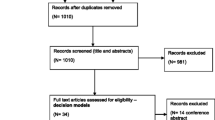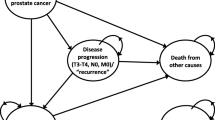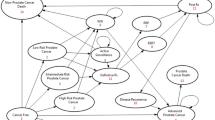Summary
Prostate cancer is a growing health problem with considerable economic consequences. Despite progress in the management of this disease, few areas in medicine generate greater disagreement. The larger part of healthcare resources are allocated to ‘halfway technologies’ aimed at palliative intervention to prolong life, while a relatively small part goes to measures aimed at preventing or curing the disease. The aetiology of this cancer is multifactorial and no practical measures for primary prevention are known.
The number of patients diagnosed with prostate cancer is increasing steadily. The age-adjusted mortality, however, has increased only slightly. In its early stages, prostate cancer is often asymptomatic and is usually not diagnosed until it has advanced. Programmes for the early detection of prostate cancer (screening) claimed to reduce morbidity and mortality are a matter of controversy. Furthermore, there has been much debate regarding optimal treatment in the early stages of the disease. Economic considerations have not as yet been integrated into studies concerning localised prostate cancer.
The routine first-line treatment of advanced prostate cancer usually involves some type of endocrine treatment. The most straightforward technique is surgical castration. Oral estrogens are as effective as castration, but have significant cardiovascular adverse effects. These may possibly be prevented if estrogens are given parenterally.
A third principal endocrine treatment is the administration of antiandrogens. Medical castration can be attained by the administration of recently developed synthetic peptides, gonadotrophin-releasing hormone [luteinising hormone-releasing hormone (LHRH)] (GnRH) analogue agonists which are given parenterally. The advantage of this type of medical castration is that the trauma of surgical castration and the adverse effects of oral estrogens are avoided.
In an attempt to improve the results obtained with endocrine treatment, the concept of combining surgical or medical castration with antiandrogens was introduced. This combination could offer improved response rates and survival in a significant number of patients. However, this advantage must be weighed against the tolerability profiles and the high costs of antiandrogens and GnRH analogues.
When using expensive drugs, the duration of treatment is a crucial factor in the total cost. As the length of treatment varies greatly between patients it is difficult to decide the most cost-effective alternative for a single individual. The patient’s preference is an important factor when selecting treatment. When there is little or no difference in the effect of different regimens the total lifetime cost is important. Few economic evaluations have been carried out in the area of prostate cancer. In view of the substantial financial burden of prostate cancer, more systematic use of health economic methods should be made, and economic considerations integrated into ongoing or planned clinical studies.
Similar content being viewed by others
References
Zaridze DG, Boyle P, Smans M. International trends in prostatic cancer. Int J Cancer 1984; 33: 223–30
Fincham SM, Hill GB, Hanson J. Epidemiology of prostatic cancer: a case-control study. Prostate 1990; 17: 189–206
Meikle AW, Smith JA. Epidemiology of prostate cancer. Urol Clin North Am 1990; 17: 709–18
National Board of Health and Welfare. Cancer incidence in Sweden 1990. Stockholm: The Cancer Registry, 1993
US Department of Health and Human Services/Public Health Service. Trends in prostate cancer — United States, 1980–1988. J Natl Cancer Inst 1992; 41: 1626–7
Möller Jensen O, Carstensen B, Glattre E, et al. Atlas of cancer incidence in the nordic countries. The Cancer Societies of Denmark, Finland, Iceland, Norway and Sweden 1988; 108–9
Möller Jensen O, Esteve J, Möller H, et al. Cancer in the European community and its member states. Eur J Cancer 1990; 26: 1167–256
Dearmaley DP, Price A, Shearer RJ, et al. Prostate cancer. Report of a meeting of physicians and scientists, Institute of Cancer Research and the Royal Marsden Hospital. Lancet 1993; 342: 901–5
Frank IN, Graham SD, Nabors WL. Urologic and male genital cancer. In: Holleb AI, Fink DJ, Murphy GP, editors. American Cancer Society textbook of clinical oncology. Atlanta GA 30329: The American Cancer Society Inc., 1991; 280–2
The National Board of Health and Welfare, The Swedish Cancer Registry. Cancer Incidence in Sweden 1990. Stockholm: 1990
A Lu-Yao GL, Greenberg ER. Changes in prostate cancer incidence and treatment in USA. Lancet 1994; 343: 251–4
Dodsorsaker 1990. Sveriges officiella Statistik. Stockholm: Statistiska Centralbyran, 1990
Seidman H, Mushinski MH, Gelb SK, et al. Probabilities of eventually developing or dying of cancer in the United States. CA Cancer J Clin 1985; 35: 36–56
Kreger BE, Splansky GL, Schatzkin A. The cancer experience in the Framingham heart study cohort. Cancer 1991; 67: 1–6
Tibblin G. Prostatic cancer — the men born in 1913 study. In: Strandberg K, Beerman B, Lönnerholm G, editors. Pharmocological treatment of prostatic cancer. Medical Products Agency, Uppsala; 1993. Workshop no.: 3, 13–9
Coffey DS. Prostate cancer — an overview of an increasing dilemma. Cancer 1993; 71 (Suppl.): 880–6
Lindgren B. Cost of illness in Sweden 1964–1975 [dissertation]. Malmo: Lund Economic Studies, 1981
Lindgren B. Cost of illness and benefits of drug treatment. ‘The economic impact of illness.’ Satellite Symposium to IV World Conference on Clinical Pharmacology and Therapeutics, 1989: Mannheim
Carlsson P, Hjertberg H, Jönsson B, et al. The cost of prostatic cancer in a defined population. Scand J Urol Nephrol 1989; 23: 93–6
Carlsson P, Pedersen K, Varenhorst E. Costs and benefits of early detection of prostatic cancer. Health Policy 1990; 16: 241–53
Gustavsson O, Norming U, Almgard L-E, et al. Diagnostic methods in the detection of prostate cancer — a study of a randomly selected population of 2400 men. J Urol 1992; 148: 1827–31
Gustafsson O, Carlsson P, Norming U, et al. Cost-effectiveness analysis in early detection of prostate cancer. An evaluation of five screening strategies in a randomly selected population of 2400 men. Prostate. In press
Optenberg SA, Thompson IM. Economics of screening for carcinoma of the prostate. Urol Clin North Am 1990; 17: 719–37
Kramer BS, Brown ML, Prorok PC, et al. Prostate cancer screening: what we know and what we need to know. Ann Intern Med 1993; 119: 914–23
Littrup PJ, Goodman AC, Mettlin CJ. The benefit and cost of prostate cancer early detection. CA Cancer J Clin 1993; 43: 134–49
Johansson JE, Adami HO, Anderssson SO, et al. High 10-year survival rate in patients with early untreated prostatic cancer. JAMA 1992; 267: 2191–6
Fleming C, Wasson JH, Albertsen PC, et al. A decision analysis of alternative treatment strategies for clinically localized prostate cancer. JAMA 1993; 269: 2650–8
Schroder FH. Endocrine therapy for prostate cancer: recent developments and current status. Br J Urol 1993; 71: 633–40
Kozlowski JM, Ellis WJ, Grayhack JT. Advanced prostatic carcinoma. Early versus late endocrine therapy. Urol Clin North Am 1991; 18: 15–24
Veterans Administration Cooperative Urological Research Group. Treatment and survival of patients with carcinoma of the prostate. Surg Gynecol Obstet 1967; 124: 1011–7
Zincke H. Combined surgery and immediate adjuvant hormonal treatment for stage D1 adenocarcinoma of the prostate: Mayo Clinic experience. Semin Urol 1990; 8: 175–83
Henriksson P, Edhag O. Cost-effectiveness comparison of estrogen therapy and orchidectomy in patients with prostatic cancer. Int J Technol Assess Health Care 1987; 3: 523–9
McClinton, Moffat LEF, Ludbrook A. The cost of bilateral orchidectomy as a treatment for prostatic carcinoma. Br J Urol 1989; 63: 309–12
Huggins C, Stevens RC, Hodges CV. Studies on prostatic cancer. II. The effects of castration on advanced carcinoma of prostate gland. Arch Surg 1941; 43: 209–23
Varenhorst E. Prostate cancer treatment: tolerance of different endocrine regimens. In: Klosterhalfen H, editor. New developments in biosciences. 4. Endocrine management of prostatic cancer. Berlin, New York: Walter de Gruyter, 1988: 105–13
Henriksson P, Stege R. Cost comparison of parenteral estrogen and conventional hormonal treatment in patients with prostatic cancer. Int J Technol Assess Health Care 1991; 7(2): 220–5
Chadwick DJ. Medical or surgical castration: The patient’s choice. Current Opinion in Urol 1992; 2: 256–8
Varenhorst E, Alund G. Urethral obstruction secondary to carcinoma of the prostate: response to endocrine treatment. Urology 1985; 25: 354–6
Kaisary AV, Tyrell CJ, Peeling WB, et al. Comparison of LHRH analogue (Zolodex) with orchiectomy in patients with metastatic prostatic carcinoma. Br J Urol 1991; 67: 502–8
Peeling WB. Phase III studies to compare goserelin (Zoladex) with orchidectomy and with diethylstilboestrol in treatment of prostatic carcinoma. Urology 1989; 33 (Suppl.): 45–52
Henriksson P, Edhag O. Orchidectomy versus oestrogen for prostatic cancer: cardiovascular effects. BMJ 1986; 293: 413–15
Haapiainen R, Ranniko S, Alfthan O. Comparison of primary orchiectomy versus estrogen therapy in advanced prostatic cancer: a 2-year follow-up report of a national, prospective prostatic cancer study. Br J Urol 1986; 58: 528–33
Johansson JE, Andersson SO, Holmberg L, et al. Primary orchiectomy versus estrogen therapy in advanced prostatic cancer — a randomized study: results after 7 to 10 years of followup. J Urol 1991; 145: 519–23
Henriksson P, Eriksson A, Stege R, et al. Cardiovascular follow-up of patients with prostatic cancer treated with single-drug polyestradiol phosphate. Prostate 1988; 13: 257
Conn PM, Crowley WK. Gonadotropin-releasing hormone and its analogues. N Engl J Med 1991; 324: 93–103
Mahler C. Is disease flare a problem? Cancer 1993; 72: 3799–802
Haggman M, Hellström M, Aus G, et al. Neoadjuvant GnRH-agonist treatment (Triptorelin and cyproterone acetate for flare protection) and total prostatectomy. Eur Urol 1993; 24: 456–60
Kuhn JM, Billebaud T, Navratil H, et al. Prevention of the transient adverse effects of a gonadotropin-releasing hormone analogue (Buserelin) in metastatic prostatic carcinoma by administration of an antiandrogen (Nilutamide). N Engl J Med 1989; 321: 413–8
Schulze H, Senge T. Influence of different types of anti-androgens on luteinizing hormone-releasing hormone analogue-induced testosterone surge in patients with metastatic carcinoma of the prostate. J Urol 1990; 144: 934–41
Goldenberg SL, Bruchovsky N. Use of cyproterone acetate in prostate cancer. Urol Clin North Am 1991; 18: 111–22
Dedaere KPJ, Van Thillo EL. Flutamide monotherapy as primary treatment in advanced prostatic carcinoma. Semin Oncol 1991; 18: 13–8
Decensi AU, Boccardo F, Guarneri D, et al. Italian prostatic cancer project. Monotherapy with nilutamide, a pure nonsteroidal antiandrogen, in untreated patients with metastatic carcinoma of the prostate. J Urol 1991; 146: 377–81
Kennealey GT, Furr BJA. Use of the nonsteroidal anti-androgen casodex in advanced prostatic carcinoma. Urol Clin North Am 1991; 18: 99–110
Crawford D, Eisenberger M, McLeod D, et al. A controlled trial of leuprolide with and without flutamide in prostatic carcinoma. N Engl J Med 1989; 321: 419–24
Janknegt RA, Abbou CC, Bartoletti R, et al. Orchiectomy and nilutamide or placebo as treatment of metastatic prostatic cancer in a multinational double-blind randomized trial. J Urol 1993; 149: 77–83
Labrie F, Dupont A, Belanger H. Complete androgen blockade for treatment of prostate cancer. In: De Vita VT, Hellman S, rosenberg JA, editors. Important advances in oncology. Philadelphia: JB Lipincott, 1985: 193–200
Soloway MS, Gomez CA. Patient selection for maximal androgen deprivation. Curr Opin Urol 1993; 3: 388–93
Denis L, Murphy GP. Overview of phase III trials on combined androgen treatment in patients with metastatic prostate cancer. Cancer 1993; 72 (Suppl.): 3888–95
De Voogt HJ, Klijn JGM, Studer U, et al. Orchidectomy versus buserelin in combination with cyproterone acetate, for 2 weeks or continuously, in the treatment of metastatic prostatic cancer. Preliminary results of EORTC-trial 30843. J Steroid Biochem Mol Biol 1990; 36: 965–9
Newling DWW. Cost-effective diagnosis and management in patients with prostate cancer. Rev Endocrine-Related Cancer 1992; 41: 23–8
Rutqvist LE, Wilking N. Analogues of LHRH versus orchidectomy: comparison of economic costs for castration in advanced prostate cancer. Br J Cancer 1992; 65: 927–9
Lindberg CF. Orkidektomi bor valjas framfor LHRH — analoger vid prostatacancer. Lakartidningen 1989; 86: 120
Nicol DL, Heathcote PS, Kateley GD, et al. Advanced prostate cancer. The role of high priced hormone therapy. Med J Aust 1993; 159: 16–9
Dalesio O. Complete androgen blockade in prostate cancer: an overview of randomized trials. Prostate 1992; 4 (Suppl.): 111–4
Ross RK, Bernstein L, Lobo RA, et al. 5-alpha-reductase activity and risk of prostate cancer among Japanese and US white and black males. Lancet 1992; 63: 2468–74
Author information
Authors and Affiliations
Rights and permissions
About this article
Cite this article
Varenhorst, E., Carlsson, P. & Pedersen, K. Clinical and Economics Conditions in the Treatment of Prostate Cancer. Pharmacoeconomics 6, 127–141 (1994). https://doi.org/10.2165/00019053-199406020-00005
Published:
Issue Date:
DOI: https://doi.org/10.2165/00019053-199406020-00005




